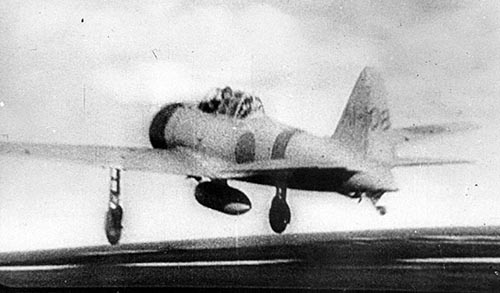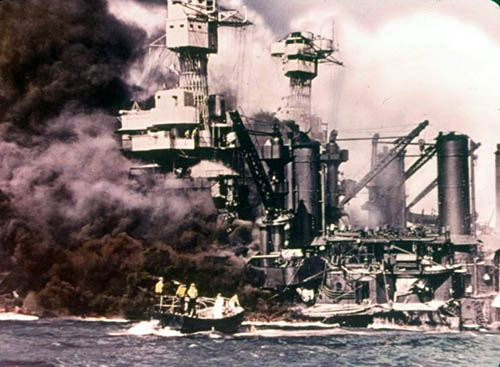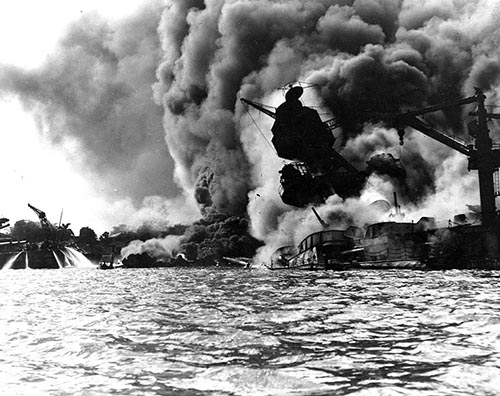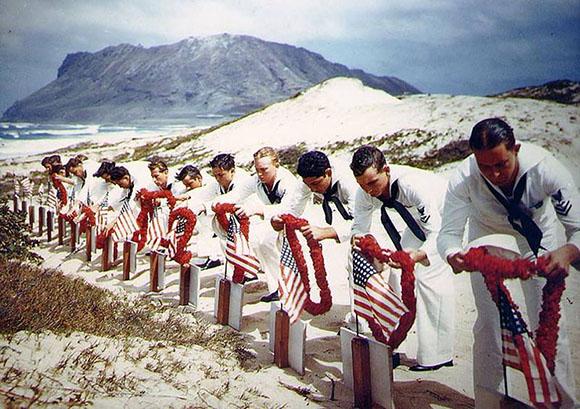December 7, 1941 is Sunday in Pearl Harbor. The island of Hawaii that welcomes the US Navy fleet under the command of Admiral Kimmel is awakened by a clear tropical sun, in what may seem like yet another lazy day of service on the edge of war. There are five minutes to 8.00 am, but something unexpected marks the cloudless celestial mantle. They are airplanes, and on closer inspection they have different lines from those that could be practiced above Wheeler o Bellows Field: I'm Nakajima B5N e Mitsubishi 'Zero'. They are Japanese aircraft, they took off from 6 aircraft carriers, 440 kilometers north of Oahu, the Akagi, Kaga, soryu, Hiryu, Shokaku, Zuikaku, and have only one goal: to annihilate the US fleet to consecrate the hegemony of the Japanese Empire over the Pacific.
352 between torpedo bombers, bombers, and fighters hit in two waves, including dive bombing, pull-ups, flights on the surface of the water and strafing at low altitude. 18 battleships and cruisers of the American Navy are totally taken aback. It is theOperation Z, was planned by the Imperial Navy admiral Isoroku Yamamoto and received the approval of Emperor Hirohito five days earlier, the 2 December.
 In a few hours the Japanese expedition destroys 200 between B-17 bombers, PBY seaplanes Catalina and hunt on the ground. Japanese planes make 3 torpedoes on battleships USS Nevada e USS California, they gut the USS Arizona centering his "holy barbarian", they make the battleship overturn in full port USS Oklahoma, knocking out the New Orleans and the two destroyers Cassin e Downes. Hangars and port facilities are razed to the ground, partially damaged several other battleships.
In a few hours the Japanese expedition destroys 200 between B-17 bombers, PBY seaplanes Catalina and hunt on the ground. Japanese planes make 3 torpedoes on battleships USS Nevada e USS California, they gut the USS Arizona centering his "holy barbarian", they make the battleship overturn in full port USS Oklahoma, knocking out the New Orleans and the two destroyers Cassin e Downes. Hangars and port facilities are razed to the ground, partially damaged several other battleships.
The third wave cannot be carried out for logistic reasons, but the effect is equally devastating: armored 8, 3 cruisers, 3 useless destroyers, dead 2.459 and injured 1.282. The only ones to be saved are the aircraft carriers USS Lexintong e USS Enterprise, out for maneuvers with their spare cruisers.
In his speech to the nation: December 7, according to President Franklin D. Roosevelt will forever remain "a date marked by infamy"; the 2.400 massacre American soldiers, taken by surprise by a country not yet declared a belligerent, will drag into the bloodiest conflict in human history, and "to absolute victory", the country that will emerge as the most influential military power in contemporary history .
The casus belli, which for the United States in the first world war was the sinking by the German submarine U-20 of theHMS Lusitania (with 123 American passengers on board), in transit to England despite the embargo communicated by the German ambassador to the USA, Franz von Pepen, this time it was a clear aggression of a military, albeit vile, nature that was premeditatedly launched during a parallel diplomatic negotiation between the two countries.

The expansionism pursued by the Japanese Empire in the East, which had led America (and later to Great Britain) to impose various countermeasures against it which culminated in the embargo of all petroleum products, metals and other strategic goods, as well as the freezing of all Japanese assets in their territories in addition to the prohibition for Japanese merchant ships to cross the Panama Canal, brought Japan, engaged in its advanced military in China and Indochina, from first to bargain with the United States (through the so-called "back door" diplomacy) a position in the Far East comparable to the "Monroe Doctrine" exercised by the US in continental America, to then end, after the rejection of the so-called "Clause A" by the United States, with an act of war, not later than but only contemporaneous with his declaration.
If the attack of Pearl Harbor in its dynamics is written history, the question that after more than 70 years still shakes the doubt of many, historians and public opinion, is: "could Pearl Harbor have been avoided?" and "Is the conspiracy theory that Americans knew about the impending attack plausible?"
At 30 years from declassification as top secret of all the documents relating to the incident, what is evident is that Pear Harbor was perhaps the clearest example of intelligence failure in history. Prior to involvement in World War II, and the establishment of the OSS (Office of Strategic Services: the US secret service founded in 1942 and operating throughout the war), the duties of espionage, counterintelligence, monitoring and encryption, were in the hands of two divided and non-assisted services: the OP-20-G which was headed byOffice of Naval Intelligence for the US Navy and the Signal Intelligence Service (SIS) for US Army. The information held by one, and the discoveries of the other, could not therefore be mutually servable and comparable.
 This is not enough, however, as a reason for failure. On the desk of President Roosvelt in fact, despite these logistical shortcomings, a 26 file from pages of the Navy's intelligence was waiting to be examined 3 well before the 4 December attack. The dossier revealed a dense network of espionage operations intent on verifying the power and displacement of the US armed forces in Hawaii, along the West Coast and in Panama, the exodus of Japanese citizens from American territory and an unusual radio and telegram traffic between the Imperial Navy and Tokyo. The dossier remained totally ignored until after the attack despite the tensions between the two countries had to foresee it on the agenda.
This is not enough, however, as a reason for failure. On the desk of President Roosvelt in fact, despite these logistical shortcomings, a 26 file from pages of the Navy's intelligence was waiting to be examined 3 well before the 4 December attack. The dossier revealed a dense network of espionage operations intent on verifying the power and displacement of the US armed forces in Hawaii, along the West Coast and in Panama, the exodus of Japanese citizens from American territory and an unusual radio and telegram traffic between the Imperial Navy and Tokyo. The dossier remained totally ignored until after the attack despite the tensions between the two countries had to foresee it on the agenda.
To this dossier is added the deciphering of the so-called "Purple Code", the encrypted code through which the Japanese emissaries communicated the conduct of the bankruptcy via diplomatic channels. All this could be a clear specter of what Japan's intentions might be. But what for conspiracy theorists is a clear expectation of degenerating events to draw from it casus belli suitable for dragging America into an unwanted war by public opinion, for strategists it is only a total absence of foresight and "lack of imagination" on the part of the leaders of the United States; that instead they were firmly convinced that the next move of the Japanese Empire in the Far East would have been the conquest of Thailand, obviously not the attack of the Hawaiian islands.
If there was no shadow of any conspiracy, although there are also rumors of a sighting by an unidentified Australian air or naval force, which would have communicated a "powerful task force en route to Hawaii "; it was fortunate that both American aircraft carriers stationed in the area, fundamental strategic weapons in the battles of the Coral Sea and the Midway Islands, were both offshore, and could, along with what remained of the fleet of the US Navy, subvert the fate of the control of the Pacific and of the whole war.
 What in recent times is described as "the second Pearl Harbor" is the terrorist attack launched by the Al Qaeda organization on the complex of the World Trade Center the 11 September 2001. Yet another casus belli to the detriment of the United States of America it brought American leadership, with George W. Bush as president, to the invasion of Afghanistan and to NATO's involvement in the fight against terrorism, which in some ways is still in vogue.
What in recent times is described as "the second Pearl Harbor" is the terrorist attack launched by the Al Qaeda organization on the complex of the World Trade Center the 11 September 2001. Yet another casus belli to the detriment of the United States of America it brought American leadership, with George W. Bush as president, to the invasion of Afghanistan and to NATO's involvement in the fight against terrorism, which in some ways is still in vogue.
Far from combining the conduct, albeit vile I repeat, of the honorable army of the Empire of the Rising Sun with that of the militants who act in the name of Islamic fundamentalism, I allow myself to drown both these dates, marked by infamy, with the memory of war, though still deplorable human action, of the most distant times; when the ethical code of honor of a fighter made man, and the war that ensued from it, with the actions that made it up was yes, worthy of men.












